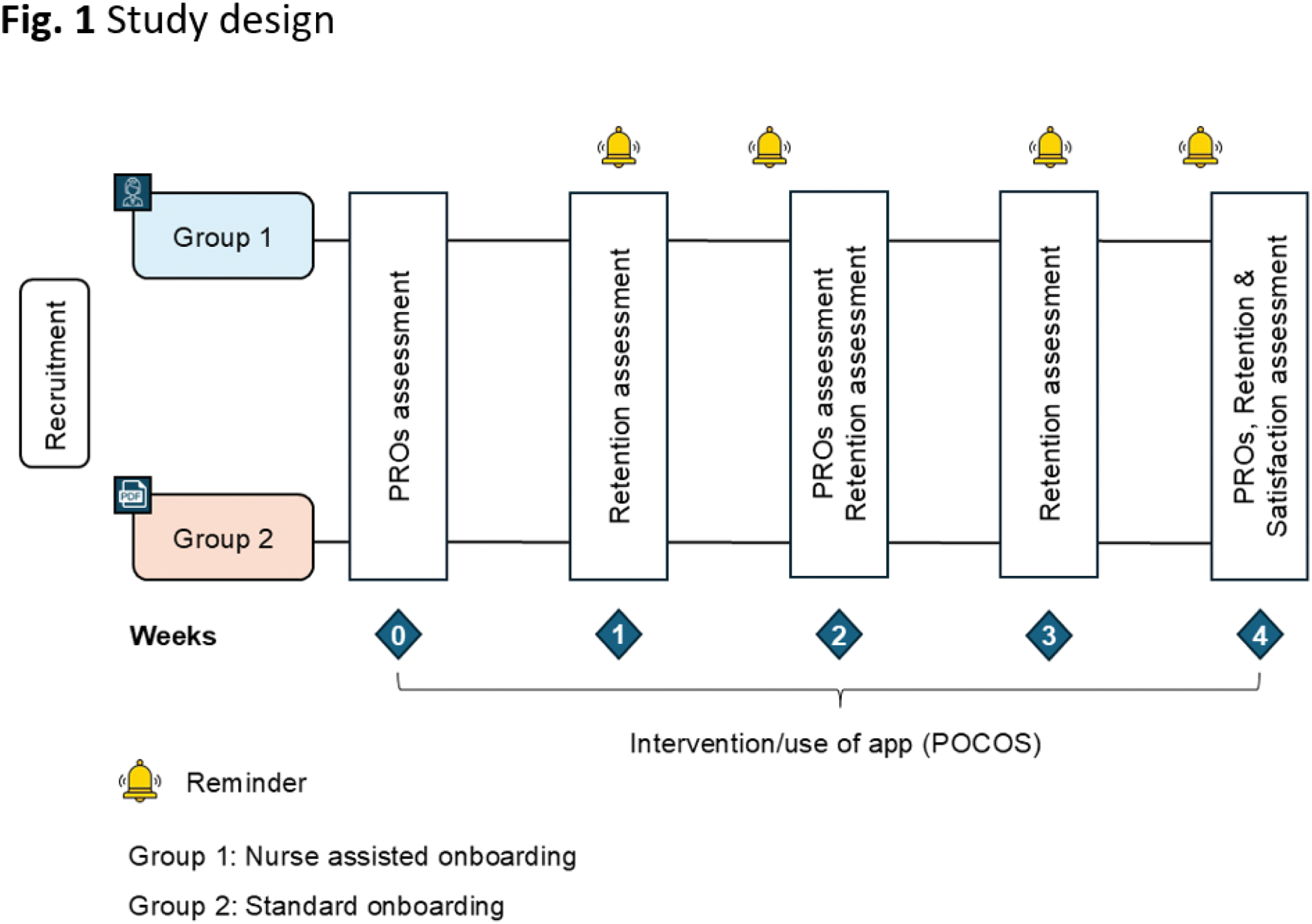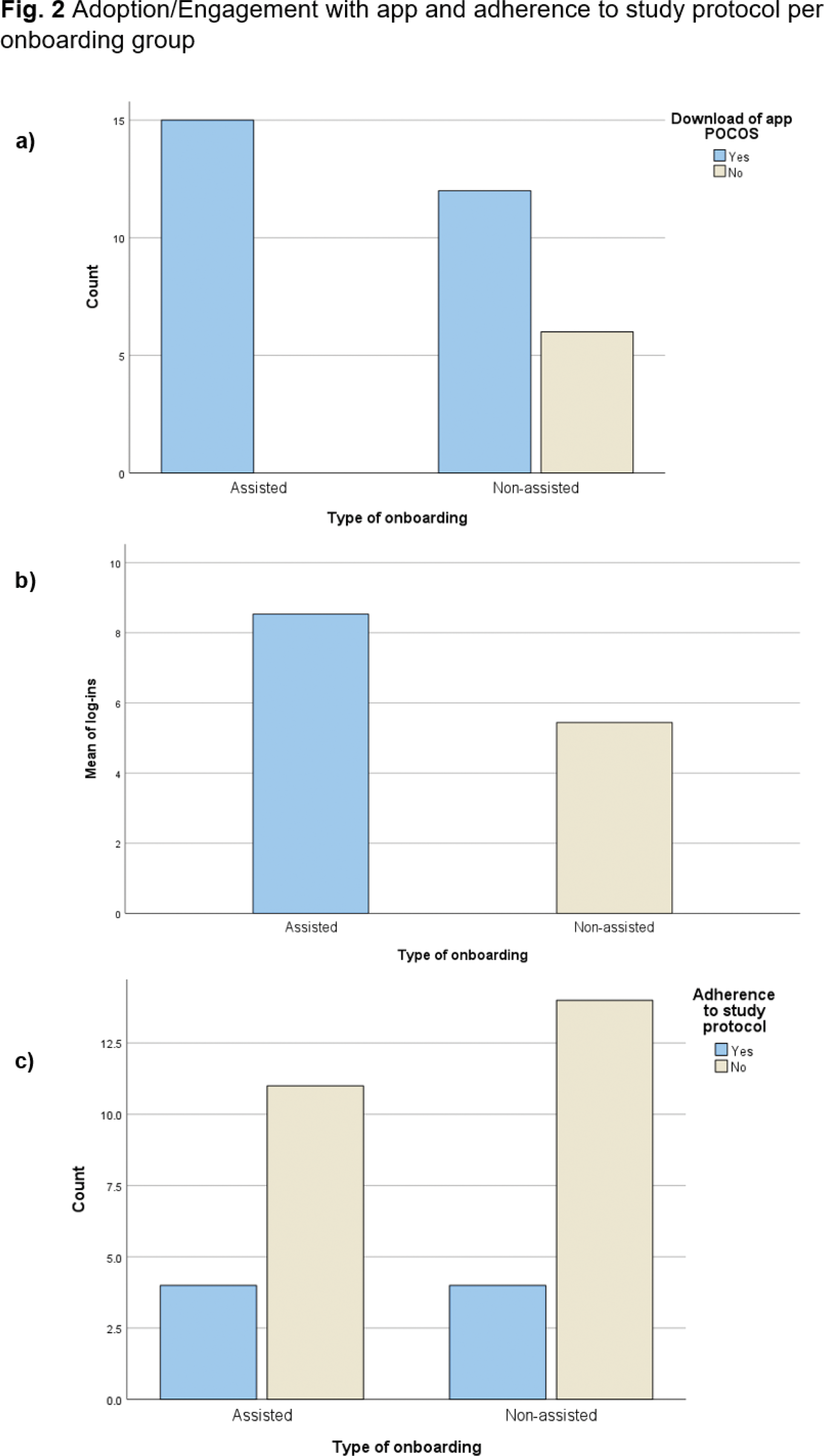

Background: Suboptimal adoption and engagement rates of digital health solutions present challenges to their effectiveness, particularly in chronic disease management like fibromyalgia. Up to 50% of patients do not download prescribed digital health apps, nor actively engage with them [1, 2], making effective onboarding a critical opportunity for improvement.
Objectives: The aim of this study is to investigate the impact of assisted vs. non-assisted patient onboarding strategies on adoption and retention to a digital health application for the symptom management of chronic pain syndromes, as well as adherence to the study protocol.
Methods: Patients (age > 18 years) suffering from chronic musculoskeletal pain, predominantly fibromyalgia, were utilizing a new self-monitoring and management app in a four-week prospective comparative study (Figure 1). The pain organizer and companion system (POCOS) consists of three components: symptom reporting, symptom monitoring and an advice and exercise section [3]. Participants in group 1 received an enhanced in-person onboarding process, which includes support for downloading the app, registering, an introduction to using the application, guidance on taking screenshots of usability data, and information on data security and the study roll-out. Group 2 received a detailed email (pdf) onboarding, providing the same information as the in-person session but without assistance. Primary outcomes included adoption rates, engagement, and adherence rates measured respectively by successful app downloads, cumulative activations and connecting minimum once per week during the four weeks.
Results: Out of the 33 patients recruited to date (mean age 46), 15 were in the assisted onboarding group and 18 were in the non-assisted group. In the assisted group, 100% (15) of the participants downloaded the application compared to 67% (12) of the non-assisted group (Figure 2a). Overall engagement, measured by cumulative app activation, ranged between 0 and 28 log-ins with mean logins not significantly different between the two groups ( p = 0.221, 8.53 for the assisted group vs. 5.44 for the non-assisted group) (Figure 2b). Adherence rates to the study protocol were 26.67% for the assisted and 22.22% for the non-assisted group, respectively (Figure 2c). The provision of usability data was limited in both groups, with only 21% (14/66) reports submitted, corresponding to 7 reports per group.
Conclusion: Unassisted downloading and installation of a health application appears to be a barrier for patients with chronic musculoskeletal pain in adopting digital health apps. We observed a trend towards improved engagement and adherence in the assisted onboarding group. Assisted onboarding can potentially enhance efficacy of health apps, as their effectiveness depends on meaningful engagement [1].
REFERENCES: [1] Strauss G, Flannery JE, Vierra E, Koepsell X, Berglund E, Miller I, et al. Meaningful engagement: A crossfunctional framework for digital therapeutics. Front Digit Health. 2022 Aug 11;4:890081.
[2] Arean PA, Hallgren KA, Jordan JT, Gazzaley A, Atkins DC, Heagerty PJ, et al. The Use and Effectiveness of Mobile Apps for Depression: Results From a Fully Remote Clinical Trial. J Med Internet Res. 2016 Dec 20;18(12):e330.
[3] Blanchard M, Koller CN, Azevedo PM, Prétat T, Hügle T. Development of a Management App for Postviral Fibromyalgia-Like Symptoms: Patient Preference-Guided Approach. JMIR Form Res. 2024 2024/4/19;8:e50832. doi: 10.2196/50832.


Acknowledgements: We would like to thank the study participants.
Disclosure of Interests: Cinja Koller: None declared , Marc Blanchard Atreon, Johanna Mettler: None declared , Tiffany Pretat: None declared , Patrick Hermann Atreon, Pedro Ming Azevedo: None declared , Thomas Hügle Abbvie, GSK, BMS, Novartis, Lilly, Werfen, Fresenius Kabi, Atreon, Vtuls.
© The Authors 2025. This abstract is an open access article published in Annals of Rheumatic Diseases under the CC BY-NC-ND license (